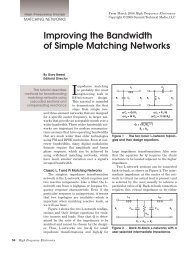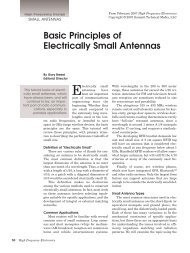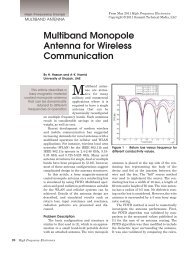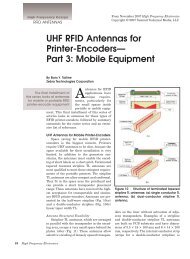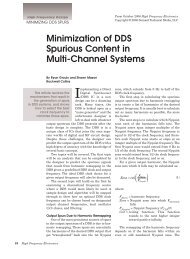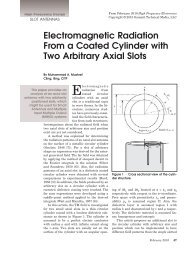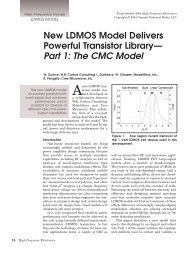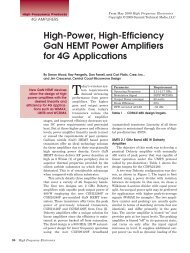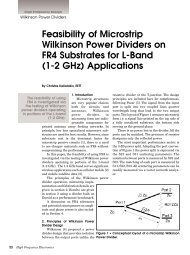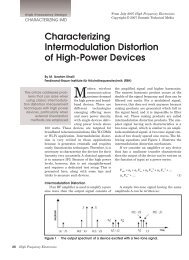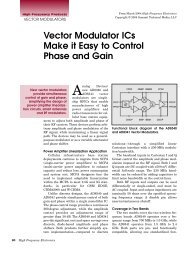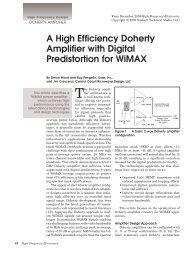High-Efficiency Linearized LDMOS Amplifiers Utilize the RFAL ...
High-Efficiency Linearized LDMOS Amplifiers Utilize the RFAL ...
High-Efficiency Linearized LDMOS Amplifiers Utilize the RFAL ...
Create successful ePaper yourself
Turn your PDF publications into a flip-book with our unique Google optimized e-Paper software.
<strong>High</strong> Frequency Design<br />
AMPLIFIER DESIGN<br />
From February 2006 <strong>High</strong> Frequency Electronics<br />
Copyright © 2006 Summit Technical Media<br />
<strong>High</strong>-<strong>Efficiency</strong> <strong>Linearized</strong><br />
<strong>LDMOS</strong> <strong>Amplifiers</strong> <strong>Utilize</strong><br />
<strong>the</strong> <strong>RFAL</strong> Architecture<br />
By Ray Gutierrez<br />
Micronda LLC<br />
The latest base station<br />
amplifier de-<br />
This article provides design<br />
and measured performance<br />
details for a power less telecom industry<br />
signs for <strong>the</strong> wire-<br />
amplifier using a recentlydeveloped<br />
technique for rate services with lower<br />
offer much higher data<br />
distortion cancellation levels of distortion than<br />
preceding designs, providing<br />
high efficiency and reliable long life at<br />
lower cost. These amplifiers are also required<br />
to be economical and work reliably over a<br />
wider range of environmental conditions than<br />
<strong>the</strong> typical air-conditioned ground-based stations.<br />
<strong>Efficiency</strong> and <strong>the</strong>rmal issues are critical<br />
to <strong>the</strong> type of power amplifier selected for<br />
<strong>the</strong>se newer applications.<br />
There are many amplifier types and architectures<br />
used for amplifying complex modulated<br />
signals. Each type has different levels of<br />
efficiency, acceptable distortion, complexity<br />
and cost:<br />
• Linear Class A <strong>Amplifiers</strong><br />
• Linear Class AB <strong>Amplifiers</strong><br />
• Parallel or Serial Combined <strong>Amplifiers</strong><br />
• Doherty <strong>Amplifiers</strong><br />
• Cartesian Loop<br />
• EE&R (Envelope Elimination &<br />
Restoration)<br />
• LINC/CALLUM (Linear Amplification<br />
using Non-Linear Components) / (Combined<br />
Analog Locked-Loop Universal<br />
Modulator)<br />
• Cross-Cancellation <strong>Amplifiers</strong><br />
• HAT (<strong>High</strong> Accuracy Tracking)<br />
• Predistortion <strong>Amplifiers</strong><br />
• Feedforward <strong>Amplifiers</strong><br />
• <strong>RFAL</strong> <strong>Amplifiers</strong> (Reflect Forward Adaptive<br />
Linearizer)<br />
Figure 1 · Block diagram showing <strong>the</strong> <strong>RFAL</strong><br />
architecture.<br />
These types of amplifiers each have advantages<br />
and disadvantages when used in different<br />
applications. The pros and cons of <strong>the</strong>se<br />
design techniques have been discussed in<br />
many previously published papers (see references).<br />
Frequently, many of <strong>the</strong> amplifier<br />
types listed are used within ano<strong>the</strong>r, such as<br />
in “feedforward” and “nested-loop feedforward”<br />
amplifier configurations.<br />
The <strong>RFAL</strong> amplifier (Reflect Forward<br />
Adaptive Linearizer) is a recently patented<br />
linearization technique that uses <strong>the</strong> information<br />
present in <strong>the</strong> reflected input signal<br />
of <strong>the</strong> first amplifier (Main 1) to create a correction<br />
signal feeding a second identical<br />
amplifier (Main 2). This significantly reduces<br />
all <strong>the</strong> distortion products of <strong>the</strong> <strong>RFAL</strong> power<br />
amplifier assembly while doubling <strong>the</strong> fundamental<br />
output power of <strong>the</strong> Main 1 amplifier.<br />
A simplified block diagram is outlined in<br />
Figure 1.<br />
22 <strong>High</strong> Frequency Electronics
<strong>High</strong> Frequency Design<br />
AMPLIFIER DESIGN<br />
Figure 2 · Block diagram of <strong>the</strong> <strong>RFAL</strong> <strong>LDMOS</strong> amplifier assembly.<br />
This technique was first published<br />
in <strong>the</strong> June 2004 issue of <strong>High</strong><br />
Frequency Electronics, “The <strong>RFAL</strong><br />
Technique for Cancellation of<br />
Distortion in Power <strong>Amplifiers</strong>.” It<br />
was also disclosed under USA Patent<br />
#6,573,793.<br />
The recent work described in this<br />
article uses <strong>LDMOS</strong> Class AB transistors<br />
to achieve a high level of IMD<br />
cancellation with high efficiency. The<br />
circuit configuration used is shown in<br />
<strong>the</strong> block diagram in Figure 2.<br />
The <strong>RFAL</strong> circuit provides 18 dB<br />
of flat gain across <strong>the</strong> 865 to 895 MHz<br />
frequency range with 40 watts PEP<br />
or +43 dBm average and IMD better<br />
than 48 dBc (two tones input, each at<br />
+22 dBm average spaced at 100 kHz).<br />
The <strong>LDMOS</strong> <strong>RFAL</strong> achieves a significant<br />
IM3 improvement of over 15<br />
dB and a total overall efficiency of<br />
>20% above <strong>the</strong> +43 dBm average P out<br />
level (Figure 3). The higher order 5th<br />
and 7th IMD term improvement were<br />
not as significant as <strong>the</strong> 3rd order<br />
IMD because <strong>the</strong> two amplifiers used,<br />
Main 1 and Main 2, are not well<br />
matched in <strong>the</strong>ir input non-linear<br />
characteristics. This issue is discussed<br />
in more detail later in <strong>the</strong> section<br />
titled “Fur<strong>the</strong>r Improvements in<br />
IMD.”<br />
Over <strong>the</strong> frequency range from<br />
865 to 895 MHz <strong>the</strong> IM3 improvement<br />
at a P out<br />
of +43 dBm average is<br />
over 16 dB. <strong>Efficiency</strong> remains at<br />
around 20% over <strong>the</strong> frequency range<br />
for power levels above +43 dBm<br />
(Figure 4).<br />
Figure 5 shows <strong>the</strong> <strong>RFAL</strong> multitone<br />
performance at composite average<br />
P out<br />
of +38.5 dBm using 8 carriers<br />
signals spaced at 300 kHz (input<br />
signals from a RDL MTG-2000 multitone<br />
generator were peaked phase<br />
aligned, and <strong>the</strong> spectrum analyzer<br />
at max hold). The <strong>RFAL</strong> shows significant<br />
IMD cancellation improvement<br />
of <strong>the</strong> Main 1 and Main 2 signals<br />
while <strong>the</strong> fundamental signals are<br />
nearly doubled.<br />
An important feature of <strong>the</strong> <strong>RFAL</strong><br />
is that it can operate <strong>the</strong> <strong>LDMOS</strong><br />
amplifiers well into <strong>the</strong> non-linear<br />
range of <strong>the</strong> transistors where <strong>the</strong><br />
efficiency is high. At this power level<br />
Figure 3 · IMD and P out<br />
Delta improvement for <strong>RFAL</strong> vs.<br />
Main 1 amplifier and <strong>RFAL</strong> total percent efficiency.<br />
(Composite average P out<br />
of two tones at f c<br />
= 880 MHz<br />
spaced as 0.1 MHz.)<br />
Figure 4 · IMD and P out<br />
Delta improvement for <strong>RFAL</strong> vs.<br />
Main 1 amplifier. (P out<br />
= 20 watts average, two tones of<br />
+40 dBm each spaced at 0.1 MHz, across <strong>the</strong> 865-895<br />
MHz band.)<br />
24 <strong>High</strong> Frequency Electronics
<strong>the</strong> <strong>RFAL</strong> can still provide an acceptable<br />
level of IMD cancellation. O<strong>the</strong>r<br />
advantages include lower transistor<br />
power dissipation that relates to<br />
higher MTBF, two separate heat<br />
sources for simplified cooling design<br />
requirements, and use of lower power<br />
transistors to achieve <strong>the</strong> desired<br />
operating power at lower costs.<br />
<strong>RFAL</strong> Component Description<br />
Main <strong>Amplifiers</strong>—The single<br />
stage <strong>LDMOS</strong> Class AB amplifiers<br />
designated Main 1 and 2 as shown in<br />
<strong>the</strong> block diagram in Figure 2 use <strong>the</strong><br />
Agere AGRA-0945-XUM plastic package<br />
transistor and is rated at 45<br />
watts PEP at 1 dB CP. The transistors<br />
on both Main amplifiers are<br />
biased at V d<br />
= 28V and I q<br />
≈ 400 mA.<br />
The combined Main amplifiers<br />
(excluding <strong>the</strong> Booster amplifiers)<br />
operate at approximately 28% efficiency<br />
with a P out<br />
of 20 watts average<br />
composite of two tones and a 35 dBc<br />
IM3 C/I for each amplifier (without<br />
<strong>the</strong> reflect path correcting signal).<br />
When used in <strong>the</strong> <strong>RFAL</strong> configuration,<br />
<strong>the</strong> transistors can be operated<br />
up to <strong>the</strong> 2 dB back-off point with<br />
significant IMD cancellation, as<br />
shown in Figure 4.<br />
Booster <strong>Amplifiers</strong>—Two amplifiers,<br />
consisting of a 1 GHz CATV<br />
CA901 hybrid module driving a single<br />
stage Freescale MRF282S<br />
<strong>LDMOS</strong> 10 watt PEP transistor. This<br />
lineup provides linear drive to <strong>the</strong><br />
Main 2 amplifier up to <strong>the</strong> +26 dBm<br />
output level with better than 55 dB<br />
C/I. The Booster amplifiers operate<br />
at +28 volts at 0.95 amp total and<br />
dissipate 26.6 watts of <strong>the</strong> total 50.4<br />
watts used by <strong>the</strong> <strong>RFAL</strong> assembly.<br />
No <strong>the</strong>rmal compensation was used<br />
with this line up. A high degree of<br />
<strong>the</strong>rmal compensation, AGC, or<br />
adaptive control circuitry will be<br />
required to operate <strong>the</strong> <strong>RFAL</strong> over a<br />
wide temperature range.<br />
Couplers—Anaren Xinger microstrip<br />
PCB mounted couplers were<br />
used for <strong>the</strong> 3 dB, 10 dB, 20 dB, and<br />
30 dB couplers.<br />
Phase Shifters—The phase<br />
shifters were made using PCB mount<br />
Soshin Electric Co GSC362-HYB0900<br />
3 dB quad couplers with Tronser sapphire<br />
trimmers. The coupler thru<br />
lines is connected to variable capacitors<br />
at each end, and <strong>the</strong> coupled line<br />
provides <strong>the</strong> input and output terminals.<br />
The configuration allows up to<br />
20 degrees of phase shift with minimum<br />
attenuation change.<br />
VVA Attenuators—The low distortion<br />
VVA consists of a four-diode π-<br />
type attenuator using Agilent HSMP-<br />
3814BLK pin diodes. (Refer to Figure<br />
3 of Avago Technologies [formerly<br />
Agilent/HP semiconductor components<br />
group] Application Note<br />
#1048.) The VVA could be replaced<br />
with fixed attenuation values with<br />
<strong>the</strong> same electrical delay after <strong>the</strong><br />
final alignment value is set. A temperature<br />
compensated attenuator<br />
could also be used to compensate for<br />
<strong>the</strong> gain variation of <strong>the</strong> Booster<br />
amplifier chain. The power dissipation<br />
of <strong>the</strong> VVA/Driver is low and was<br />
not included in total <strong>RFAL</strong> current.<br />
Isolators—The Isolators were<br />
used to provide good isolation and<br />
transistor protection while aligning<br />
<strong>the</strong> circuit. It is possible to remove<br />
<strong>the</strong>se isolators after <strong>the</strong> circuit<br />
works properly across <strong>the</strong> desired<br />
frequency range. The main delay and<br />
forward path delay will have to be<br />
adjusted to achieve <strong>the</strong> same electrical<br />
delay as before. The circuit uses<br />
Alcatel Ferrocom Model 9A72-31<br />
(850 to 950 MHz) circulators with 50-<br />
ohm loads.<br />
Delay Lines—The Main 1 output<br />
delay line is approximately 10 feet in<br />
length using Times Microwave cable<br />
LMR-400-PVC CATV ® (UL) plus 2<br />
feet of semi-rigid coax and various N<br />
and GR connectors to select <strong>the</strong> final<br />
delay length. Coaxial cables were<br />
added to <strong>the</strong> Forward and Reflected<br />
path delays of <strong>the</strong> Main 2 path, and<br />
<strong>the</strong> phase shifters were adjusted to<br />
accommodate <strong>the</strong> Main 1 path fixed<br />
delay. After electrical alignment is set<br />
<strong>the</strong> Reflect path delay can be reduced<br />
to <strong>the</strong> minimum length possible. That<br />
same amount of delay removed from<br />
<strong>the</strong> Reflect path needs to be removed<br />
<strong>the</strong>n from <strong>the</strong> Main path and <strong>the</strong> forward<br />
path to correctly match all signal<br />
paths. The delay lines for this<br />
particular assembly can be reduced<br />
considerably by more efficient and<br />
compact layout of <strong>the</strong> amplifiers and<br />
couplers.<br />
Electrical Alignment<br />
• Main amplifiers 1 and 2 should be<br />
independently aligned to match<br />
each o<strong>the</strong>r as best as possible in<br />
terms of gain, return lLoss, insertion<br />
phase and IMD versus input<br />
power and dc bias point.<br />
• The VVA and Booster amplifier<br />
chain must be able to reproduce <strong>the</strong><br />
input drive to <strong>the</strong> <strong>RFAL</strong> with minimum<br />
or no distortion. The Main 1<br />
amplifier must be biased-on before<br />
Main 2 and before RF drive is<br />
turned on, o<strong>the</strong>rwise excessive<br />
drive may be applied to <strong>the</strong> Main 2<br />
amplifier due to excessive reflected<br />
power from Main 1.<br />
• The Main 1 output delay and <strong>the</strong><br />
reflect path electrical delay and<br />
VVA amplitude level are adjusted<br />
to obtain IMD cancellation at <strong>the</strong><br />
output of <strong>the</strong> <strong>RFAL</strong>; <strong>the</strong>re should<br />
be minimum effect to <strong>the</strong> fundamental<br />
power over <strong>the</strong> operational<br />
frequency range.<br />
• The correcting input signal reflected<br />
from Main 1, which is <strong>the</strong>n coupled<br />
through <strong>the</strong> reflected path, is<br />
attenuated, delayed and amplified<br />
by <strong>the</strong> Booster amplifiers. The signal<br />
from <strong>the</strong> Booster amplifiers<br />
must have <strong>the</strong> right amount of IMD<br />
signal level for cancellation of <strong>the</strong><br />
Main 2 internally generated intermods<br />
and also an additional level<br />
sufficient to cancel <strong>the</strong> IMDs of <strong>the</strong><br />
Main 1 at <strong>the</strong> output of <strong>the</strong> <strong>RFAL</strong>’s<br />
coupler. (This assumes optimum<br />
signal phasing to cause cancellation<br />
of all IMDs.)<br />
• The forward path VVA level is<br />
adjusted to drive <strong>the</strong> Main 2<br />
amplifier to <strong>the</strong> same level as <strong>the</strong>
<strong>High</strong> Frequency Design<br />
AMPLIFIER DESIGN<br />
Main 1 amplifier. The forward path delay and VVA<br />
level are adjusted to obtain flat output power over <strong>the</strong><br />
full operating frequency band. The forward delay<br />
should match <strong>the</strong> reflected path delay to achieve optimum<br />
cancellation of IMD and maximum combining of<br />
fundamental power.<br />
• The DC Bias (I q<br />
) point of both Main amplifier transistors<br />
are critical to achieve optimum cancellation. The<br />
bias point of both Main amplifiers can be adjusted<br />
slightly to find <strong>the</strong> best IMD cancellation versus input<br />
drive. The level of cancellation possible is interrelated<br />
to <strong>the</strong> level of intermod match performance of <strong>the</strong> two<br />
Main amplifiers over <strong>the</strong> operational drive levels and<br />
over <strong>the</strong> frequency band.<br />
Fur<strong>the</strong>r Improvements in IMD<br />
The <strong>LDMOS</strong> transistors used for <strong>the</strong> Main 1 and Main<br />
2 amplifiers for <strong>the</strong> presented <strong>RFAL</strong> assembly were not as<br />
well matched as expected. Ideally, it is desirable to have<br />
<strong>the</strong> output and reflected input intermods (IMD 3rd, IMD<br />
5th, IMD 7th) to have a constant level difference over <strong>the</strong><br />
input power range and operating frequency range.<br />
(IMx out – IMx in) = (Constant dB value)<br />
Ideally this constant dB value should be <strong>the</strong> same for x<br />
= 3rd, 5th, 7th, etc… intermods for both Main 1 and Main<br />
2 amplifiers. A constant dB value allows a fixed amount of<br />
gain from <strong>the</strong> Booster amplifier chain to provide <strong>the</strong> correct<br />
level for perfect cancellation across <strong>the</strong> input drive and frequency<br />
ranges. (This assumes a perfect phase match.)<br />
The constant dB value is not exactly <strong>the</strong> same for each<br />
transistor and may be different for specific quiescent values<br />
of <strong>the</strong> drain current (I q<br />
). The ideal I q<br />
value for each amplifier/transistor<br />
can be selected to provide <strong>the</strong> best performance<br />
trade-off over <strong>the</strong> input drive and over <strong>the</strong> operating<br />
frequency range. Normally <strong>the</strong> optimum I q<br />
value for <strong>the</strong><br />
Main amplifier’s transistor used in <strong>the</strong> <strong>RFAL</strong> configuration<br />
would be lower than <strong>the</strong> “sweet-spot” bias point found for<br />
IM3 in most data sheets for <strong>the</strong> <strong>LDMOS</strong> transistor.<br />
To increase <strong>the</strong> level of match between <strong>the</strong> main<br />
amplifiers, an approach similar to that used for <strong>the</strong> manufacturing<br />
of CATV push-pull hybrid amplifiers or pushpull<br />
power transistors in a single package could be used.<br />
For CATV amplifiers <strong>the</strong> transistor die is selected so that<br />
<strong>the</strong> set is picked from adjacent locations in <strong>the</strong> transistor<br />
wafer. Preferably, although more costly, <strong>the</strong> transistors<br />
can be manufactured as a MMIC set. This will increase<br />
<strong>the</strong> level of match and improve <strong>the</strong> level of IMD cancellation<br />
over a wider input drive level.<br />
Figure 5 · <strong>RFAL</strong> vs. Main 1 amplifier (spectrum with 8<br />
carriers peaked phase and peak hold).<br />
Thermal Issues<br />
The <strong>RFAL</strong> allows operation of <strong>the</strong> transistors at higher<br />
RF power levels where <strong>the</strong> transistors are more efficient<br />
while providing acceptable cancellation of <strong>the</strong><br />
unwanted distortion. <strong>High</strong>er efficiency in amplifiers corresponds<br />
to lower dissipated power and results in smaller<br />
heat sink and cooling necessary for reliable operation. The<br />
<strong>RFAL</strong> uses two power transistors to achieve <strong>the</strong> desired<br />
output power level. Separation of <strong>the</strong>se heat sources<br />
results in more effective cooling and longer operating life.<br />
Performance and Cost Issues<br />
The <strong>RFAL</strong> uses smaller geometry type transistors to<br />
achieve <strong>the</strong> same level of operational power without<br />
heavy OPBO for a given level of IMD (OPBO = Operating<br />
Back-Off Point from 1 dB compression). Smaller geometry<br />
transistors are cheaper and easier to match over a wider<br />
operating bandwidth. Since only two transistor stages are<br />
used, <strong>the</strong> task of adjusting <strong>the</strong> delay lines and amplitude<br />
levels is easier than in multistage-type feedforward<br />
amplifiers. However, a high level of accuracy in amplitude<br />
and phase control is necessary to achieve >15 dB of cancellation,<br />
as is required for <strong>the</strong> feedforward amplifier configuration.<br />
The amplitude and level control can be more<br />
manageable if <strong>the</strong> transistors are carefully matched<br />
before constructing <strong>the</strong> Main amplifiers and by careful<br />
temperature compensation of <strong>the</strong> Booster amplifier chain.<br />
Conclusion<br />
The <strong>RFAL</strong> architecture provides a useful alternative for<br />
<strong>the</strong> design of low distortion power amplifiers. It provides:<br />
• <strong>High</strong> level of IMD cancellation with simple circuit configuration.<br />
• <strong>High</strong> operating efficiency (>20% overall efficiency is<br />
possible)<br />
26 <strong>High</strong> Frequency Electronics
<strong>High</strong> Frequency Design<br />
AMPLIFIER DESIGN<br />
• Lower transistor power dissipation, which correlates to<br />
improved <strong>the</strong>rmal design<br />
• Achieves operational power with low distortion using<br />
economical transistors<br />
• Potential for dense packaging using microcircuit hybrid<br />
assembly or MMIC.<br />
Acknowledgments<br />
Thanks to Edward Lau formerly from Agere Systems<br />
and now with Ciclon Semiconductor for his support. Also<br />
thanks for <strong>the</strong> trimmer capacitor samples provided by<br />
Tronser, Inc., and thanks to Soshin Electronics for <strong>the</strong>ir<br />
miniature LTCC couplers.<br />
References<br />
1. US Patent 6,573,793, “Reflect Forward Adaptive<br />
Linearizer.” June 3, 2003.<br />
2. Romulo (Ray) Gutierrez, “The <strong>RFAL</strong> Technique for<br />
Cancellation of Distortion in Power <strong>Amplifiers</strong>,” <strong>High</strong><br />
Frequency Electronics, June 2004.<br />
3. Nick Po<strong>the</strong>cary, Feedforward Linear Power<br />
<strong>Amplifiers</strong>, Artech House Inc., 1999.<br />
4. Peter B. Kenington, “Methods Linearize RF<br />
Transmitters and Power Amps, Parts 1 & 2,” Microwaves<br />
& RF, December 1998 and January 1999.<br />
5. Joseph M. Madden, “Evolution Through Technology,”<br />
Applied Microwaves & Wireless, October 1999.<br />
6. Allen Katz, “Linearizing <strong>High</strong> Power <strong>Amplifiers</strong>,”<br />
Application Note from Linearizer Technology, Inc.<br />
Author Information<br />
Ray Gutierrez is President of Micronda LLC consulting<br />
services. Previously he was VP of Engineering and one<br />
of <strong>the</strong> four founders of Phoenix Microwave Corp. Ray can<br />
be reached via email at: ray@micronda.com.<br />
AUTHORS — <strong>High</strong> Frequency Electronics invites articles on any topic of interest to engineers working in RF,<br />
microwave, mm-wave, optical and high-speed digital technologies. To meet our readers’ needs, we publish<br />
articles with a range of technical depth from basic tutorial to advanced <strong>the</strong>ory. Contact <strong>the</strong> Editorial Director<br />
with your idea; an abstract, outline or o<strong>the</strong>r brief description is all that is necessary. Send it by e-mail to:<br />
gary@highfrequencyelectronics.com, by fax to +1 608-845-3976 or by mail to <strong>the</strong> address on page 6.<br />
28 <strong>High</strong> Frequency Electronics



